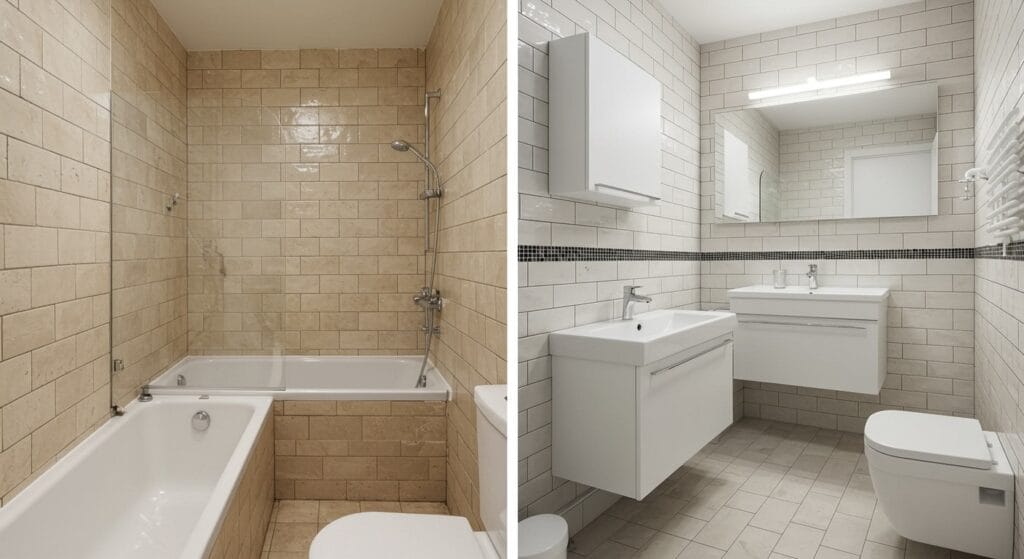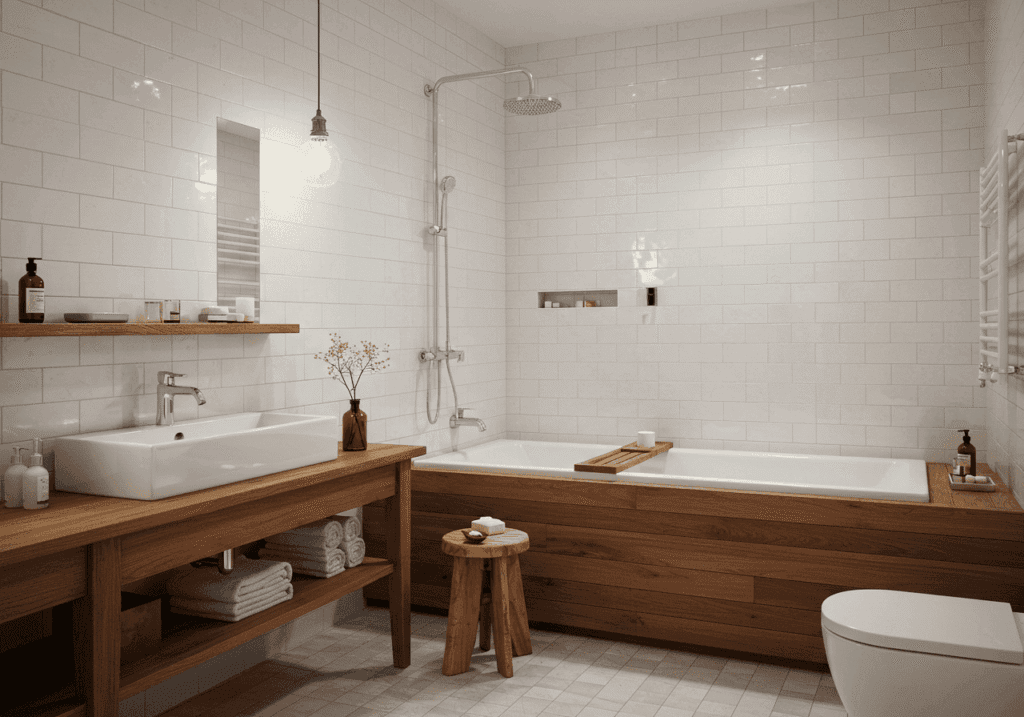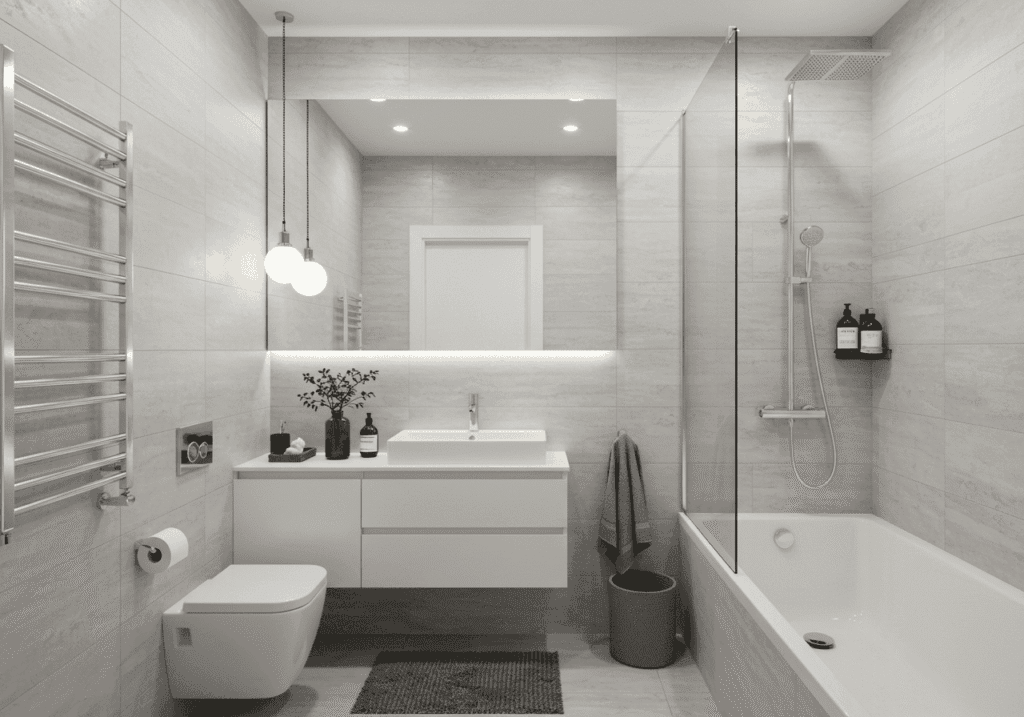That cramped bathroom feeling you every morning? It doesn’t have to stay that way. The right tile choices can completely transform how spacious your small bathroom feels, and honestly, some of these tricks will surprise you with how well they work.
I’ve been obsessing over small bathroom transformations lately, and the difference the right tiles can make is genuinely mind-blowing. Whether you’re dealing with a powder room that feels like a closet or a full bath that’s just… snug, these tile ideas will help you maximize every square inch visually.
The best part? Most of these solutions don’t require a complete gut renovation. Sometimes it’s just about choosing tiles that work with your space instead of against it.
Why Tile Choice Matters More in Small Bathrooms
Small bathrooms are unforgiving – every design choice gets magnified. While you might get away with bold, chunky tiles in a spacious master bath, compact spaces need more strategic thinking.
The way light bounces off surfaces, how your eye travels across patterns, and even the grout lines you choose all play into whether your bathroom feels cramped or surprisingly roomy. It’s fascinating how much psychology comes into play with tile selection.
Think about it – when you walk into a small bathroom, your brain immediately starts measuring the space. The right tiles can trick that mental measuring tape into thinking there’s more room than there actually is.
Light and Bright: The Foundation of Spacious Design
1. Classic White Subway Tiles with Varied Layouts
White subway tiles aren’t boring – they’re brilliant for small spaces. But here’s where it gets interesting: how you arrange them completely changes the feel of your room.
Try running them vertically instead of horizontally to draw the eye upward and create height. Or mix orientations within the same space for visual interest without overwhelming the room.
The clean lines and reflective surface bounce light around beautifully, and that classic look never goes out of style. Plus, white subway tiles pair with literally any accent color you might want to add later.
2. Large Format Light Gray Tiles
Bigger tiles mean fewer grout lines, and fewer grout lines mean less visual interruption. Large format tiles in soft gray create this beautiful, continuous surface that makes walls seem to stretch.
Gray is having such a moment right now, but more importantly, it’s incredibly forgiving and sophisticated. It hides water spots better than pure white while still keeping things light and airy.
The key is choosing tiles that are at least 12×24 inches – any smaller and you lose that seamless effect you’re going for.
3. Glossy White Ceramic for Maximum Reflection
Sometimes you need all the light help you can get, and glossy tiles are like adding extra windows to your space. The reflective surface literally multiplies whatever natural light you have.
I know glossy tiles get a bad rap for showing water spots, but in a small bathroom renovation, the space-enhancing benefits often outweigh the extra cleaning.
Consider using glossy tiles on just one accent wall if you’re worried about maintenance – you’ll still get that light-bouncing effect without committing to high-gloss everything.
Playing with Patterns to Create Movement
4. Diagonal Tile Installation
Here’s a trick that works like magic: install square tiles on the diagonal instead of straight. Your eye follows those angled lines, and somehow the space feels wider than it actually is.
This works particularly well on floors, where those diagonal lines create this beautiful sense of movement. It’s one of those simple changes that delivers surprisingly dramatic results.
Just make sure you have enough tile – diagonal installation typically requires about 10% more material due to cutting and waste.
5. Vertical Stripe Patterns
Vertical stripes aren’t just for fashion – they work wonders in small bathroom design too. Alternate between two similar shades or even different textures in the same color family.
The key is subtlety. You want stripes that create movement without being too busy or overwhelming in a compact space.
This technique is particularly effective on the longest wall in your bathroom, drawing the eye up and making the ceiling feel higher than it is.
6. Chevron Tile Layout
Chevron patterns add this gorgeous sense of movement and energy to small spaces. The V-shaped pattern naturally draws your eye across the wall, making it feel wider.
Choose tiles in similar tones to keep the pattern from becoming too busy. The goal is subtle sophistication, not visual chaos.
This works beautifully as an accent wall behind the vanity or in the shower area – somewhere it can make a statement without overwhelming the entire space.
Strategic Color Choices That Expand Space
7. Soft Blue-Gray Tiles
Blue-gray is having such a moment, and for good reason. These cooler tones naturally recede, making walls feel like they’re further away than they actually are.
The color reminds me of a calm sky or gentle ocean – there’s something inherently spacious about those associations. Your brain connects that color with open, expansive spaces.
This works especially well in bathrooms with limited natural light, where the cool tones help create a sense of airiness that warm colors might close in.
8. Warm White with Cool Undertones
Not all whites are created equal, and the undertones matter more than you might think. Warm whites with cool undertones give you the brightness you need while feeling fresh and current.
These tiles work beautifully with both modern and traditional fixtures, making them a safe choice if you’re not ready to commit to a specific style direction.
The cool undertones prevent that sterile hospital feeling while still maximizing light reflection and creating visual space.
9. Sage Green Subway Tiles
Sage green might seem risky for a small space, but hear me out. This particular green has gray undertones that keep it from feeling too bold or overwhelming.
Green is naturally connected to growth and renewal – there’s something about it that feels expansive rather than confining. Plus, it’s incredibly soothing and spa-like.
The trick is balancing it with plenty of white trim and light fixtures to keep the overall feeling bright and airy.
Creative Layout Solutions
10. Running Bond Pattern
The running bond pattern is like the brick pattern’s sophisticated cousin. Instead of stacking tiles directly on top of each other, each row is offset by half a tile length.
This creates beautiful horizontal movement that can make narrow bathrooms feel wider. The eye follows those staggered lines across the wall rather than getting stuck on rigid grid patterns.
It works with any rectangular tile – subway tiles, larger format rectangles, or even natural stone tiles cut into planks.
11. Basket Weave Floor Pattern
Basket weave patterns add incredible visual texture without being too busy for small spaces. The interlocking rectangular pattern creates this beautiful sense of movement and sophistication.
This pattern works particularly well on floors, where it adds interest without competing with wall treatments. It’s classic enough to feel timeless but interesting enough to feel special.
Choose tiles in similar tones to let the pattern shine without creating too much contrast that could make the space feel choppy.
12. Mixed Size Tile Installation
Mixing different sizes of the same tile creates visual rhythm and prevents that monotonous feeling that can make small spaces feel even smaller. Think large tiles with smaller accent pieces.
The key is sticking to the same color family and finish – you want the size variation to add interest without creating chaos. This approach works beautifully in spa-like bathroom decor.
Try pairing 12×24 inch tiles with 4×12 inch pieces, or mixing square and rectangular shapes in complementary sizes.
Texture and Finish Strategies
13. Matte Finish Tiles for Subtle Sophistication
Matte finishes are having such a moment right now, and they work beautifully in small bathrooms where you want sophistication without the high-maintenance shine of glossy tiles.
The non-reflective surface creates this beautiful, soft appearance that feels warm and inviting. While you lose some light reflection, you gain this gorgeous, high-end look.
Matte tiles also hide water spots and fingerprints much better than glossy options – a practical consideration in frequently used spaces.
14. Textured Stone-Look Tiles
Stone-look tiles give you that gorgeous natural texture without the maintenance headaches of actual stone. The subtle texture adds visual interest without overwhelming small spaces.
Choose lighter stone looks – think travertine or light limestone rather than dark slate. The natural variations in the pattern help hide everyday wear while adding sophisticated appeal.
These work particularly well as accent walls or in shower areas where you want that spa-like, natural feeling.
15. Wood-Look Tiles for Warmth
Wood-look tiles are perfect for adding warmth to small bathrooms without worrying about moisture damage. Light wood tones particularly help spaces feel larger and more inviting.
The linear nature of wood planks naturally draws the eye along their length, creating the illusion of more space. Install them horizontally to make rooms feel wider, or vertically to add height.
Modern wood-look tiles are incredibly realistic – many are nearly indistinguishable from actual hardwood but completely waterproof and durable.
Bold Moves That Surprisingly Work
16. Dark Accent Wall Strategy
Here’s something counterintuitive: one dark accent wall can actually make a small bathroom feel larger by creating depth and dimension. The key is choosing just one wall – usually the one behind the vanity.
The contrast between dark and light creates visual layers, and your eye reads that depth as more space. It’s like adding a shadow that suggests the room extends further back.
Choose deep blues, rich grays, or even dramatic blacks for the most impact. Keep the other three walls light to maintain balance.
17. Bold Geometric Patterns in Small Doses
Geometric patterns can work in small bathrooms – you just need to use them strategically. Try them in shower niches, as a small backsplash, or as a border accent.
The key is proportion. Bold patterns need breathing room, so pair them with plenty of solid, neutral tiles. Think of the pattern as jewelry – a beautiful accent, not the entire outfit.
Hexagons, diamonds, and modern geometric shapes can add incredible visual interest when used thoughtfully.
18. Metallic Accent Tiles
Metallic accents catch and reflect light beautifully, adding glamour and visual interest to small spaces. Think gold, bronze, or silver tiles used as borders or accent strips.
The reflective quality helps bounce light around the room, while the metallic finish adds a luxurious feeling that makes the space feel more expensive and thoughtfully designed.
Use them sparingly – as a border around mirrors, as accent strips in shower areas, or as small mosaic details.
Smart Solutions for Specific Challenges
19. Penny Tiles for Curved Surfaces
Penny tiles are perfect for small bathrooms with curved architectural details. The small, round format adapts beautifully to curves while creating this gorgeous, vintage-inspired texture.
While you might think small tiles would make a small space feel busy, penny tiles actually create a unified surface that reads as one cohesive element. The numerous grout lines blend together into texture rather than individual pieces.
Choose light colors and consistent grout for the most space-enhancing effect.
20. Long Rectangular Tiles for Narrow Bathrooms
In really narrow bathrooms, long rectangular tiles installed horizontally can work magic. The horizontal lines literally train your eye to see width instead of narrowness.
Choose tiles that are at least three times longer than they are wide for the most dramatic effect. The fewer vertical grout lines you have, the wider the space will feel.
This technique works on both walls and floors, though it’s particularly effective on the longest wall in your space.
21. Mirror-Finish Tiles for Ultimate Light Reflection
Mirror tiles take light reflection to the next level. While they require more maintenance than regular tiles, the space-enhancing effect is dramatic.
Use them strategically – perhaps just on one wall or as accent strips. Too much mirror can feel overwhelming, but the right amount creates this beautiful sense of infinite space.
Choose high-quality mirror tiles designed for bathroom use to ensure they’ll hold up to moisture and humidity.
22. Mosaic Tiles with Subtle Color Variation
Mosaic tiles with subtle color variation create beautiful depth and movement without being too busy for small spaces. Think whites and creams, or soft grays with slightly darker accents.
The variation prevents that flat, monotonous feeling while the similar tones keep the overall effect calm and spacious. Your eye reads movement and interest without chaos.
This works particularly well in shower areas or as accent walls where you want texture and visual interest.
Making Your Choice: Practical Considerations
Choosing tiles for your small bathroom isn’t just about what looks good in pictures – you need to consider your specific space, lighting, and lifestyle needs.
Think about how much natural light your bathroom gets. Spaces with lots of natural light can handle slightly bolder choices, while bathrooms with minimal windows benefit from lighter, more reflective options.
Consider your storage and organization needs too. Some tile layouts work better with built-in niches and storage solutions than others.
Your maintenance preferences matter as well. Some finishes require more upkeep but deliver more dramatic visual impact. Be honest about what you’re willing to maintain long-term.
Remember that tile is a long-term investment – choose something you’ll still love in five or ten years. Trends come and go, but good design principles are timeless.
The most important thing is choosing tiles that make you happy every time you walk into your bathroom. After all, you’re the one who has to live with them every day. When your small bathroom feels spacious, beautiful, and uniquely yours, you’ve made the right choice.


